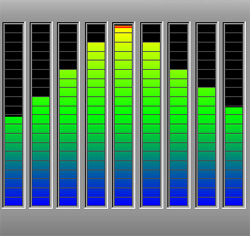
We see mic level coming from mics (obviously) as well as DIs (direct injection boxes). A DI turns unbalanced, high impedance signals into a balanced, low impedance mic level signal so it can be sent a longer distance.
I’ll deal with balanced/unbalanced signals in another post; for now think of them this way—balanced = 3 wires = better for longer runs, unbalanced = 2 wires = good only for short (2-15-foot) runs.
Line Level
Most professional audio gear using line level signals runs at +4 dBV, which corresponds to a little over 1.5 V. Whereas mic level signals are almost always balanced, line level can be either balanced or unbalanced.
Line level is typically high impedance, on the order of 1,000 ohms (1K ohm) or so, but because the signal level is so much higher than mic level, we can send it long distances (at least if it’s balanced).
I want to pause here for a moment to consider some practical implications. Let’s say you plug a line level signal into an input that’s designed for mic level. What would happen?
Going back to our numbers, you have an input that’s looking for 1 mV and you shove 1V into it. That’s about 1,000 times as much signal as it’s expecting (see why we use dB instead of volts? We can say 64 dB instead of 1,000 volts). You don’t have to be an electrical engineer to guess that the result will not be pleasant. While the input it not likely to be destroyed, the audio signal will be. Gross distortion will be the audible result.
On the other hand, if we plug a mic level signal into an input that is expecting a line level signal, what might happen? Again, we’re feeding a signal that’s roughly 1,000 times lower than expected; so the result will be low signal level and high noise. Starting to make sense?
Speaker Level
The third common type of signal we deal with in audio is speaker level. Speaker level is very high level (+22-33 or more dBV and can range from 11-89 volts) and very low impedance (4-16 ohms typically).
With that kind of signal level on hand, it’s pretty clear why we don’t want to plug a speaker level signal into a mic level input. That might actually blow something up. And it’s also why we can’t drive a speaker with the output of a microphone, at least not directly.
Now we could talk about the intricacies of these signaling levels for the next two weeks, but I’m trying to keep the post length manageable. In the meantime, do some research on your own. You’ll be amazed at how much more of audio makes sense when you have a firm grasp of these concepts.
Mike Sessler is the Technical Director at Coast Hills Community Church in Aliso Viejo, CA. He has been involved in live production for over 20 years and is the author of the blog, Church Tech Arts . He also hosts a weekly podcast called Church Tech Weekly on the TechArtsNetwork.
